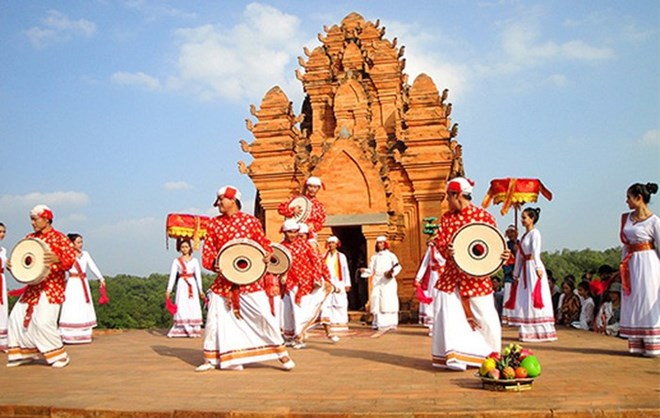
An exhibition featuring the 2018 Kate Festival, the most important annual celebration of the ethnic Cham Brahman community, opened in the central province of Ninh Thuan on October 8.

At Kate festival (Source: baomoi)
On the occasion, Mukha Linga and Po Long Girai statues, along with
Nandin, Patil, and Banal sacred bulls, costumes, and musical instruments were
introduced to the public, contributing to maintaining, preserving, and
upholding values of national cultural heritage.
Le Xuan Loi, Director of the Research Centre for Cham Culture in Ninh Thuan,
said the display aims to popularise the unique culture of the Cham ethnic group
in Ninh Thuan amongst domestic and foreign visitors.
On the occasion of Kate festival 2018, antique collectors from across the
nation and abroad donated 14 valuable objects of different materials and dates
to the centre, which offer visitors an insight into the iron casting, pottery
making, and fabric weaving of the Cham people.
Since 2010, the centre has received over 900 valuable artifacts from antique
collectors.
Source: VNA
With an increasingly vibrant and widespread emulation movement aimed at building cultured residential areas and cultured families, Yen Thuy District has been making steady progress toward improving both the material and spiritual well-being of its people, while fostering a civilized, prosperous, beautiful, and progressive community.
Once lacking recreational spaces and community facilities, Residential Group 2 in Quynh Lam Ward (Hoa Binh City) has recently received attention for the construction of a new, spacious, and fully equipped cultural house. The project followed the model of state support combined with public contributions in both labor and funding.
The "All people unite to build cultural life" movement, which has been effectively integrated with Kim Boi district’s socio-economic development goals, is fostering a lively spirit of emulation across local residential areas, hamlets, villages, public agencies, and enterprises. In addition, through the initiative, traditional cultural values are being preserved and promoted, while community solidarity and mutual support in poverty reduction and economic development are being strengthened.
A working delegation of the Hoa Binh provincial People’s Committee led by its Permanent Vice Chairman Nguyen Van Toan on June 11 inspected the progress of a project to build the Mo Muong Cultural Heritage Conservation Space linked to tourism services in Hop Phong commune, Cao Phong district.
Born and growing in the heroic land of Muong Dong, Dinh Thi Kieu Dung, a resident in Bo town of Kim Boi district, in her childhood was nurtured by the sweet lullabies of her grandmother and mother. These melodies deeply imprinted on her soul, becoming an inseparable part of her love for her ethnic group's culture. For over 20 years, this love for her hometown has driven Dung to research, collect, and pass down the cultural values of the Muong people to future generations.
In the final days of May, the Ethnic Art Troupe of Hoa Binh Province organized performances to serve the people in remote, mountainous, and particularly disadvantaged areas within the province. These were not just ordinary artistic shows, but they were the meaningful journeys aimed at spreading cultural values, enhancing the spiritual life of the people and contributing to the preservation of ethnic minority cultural identities.



